07/08/2022 – By Frédéric de Kemmeter – Railway signalling and freelance copywriter – Suscribe my blog
(Version en français)
🟧 Back to homepage 🟧 See our brief news
Don’t ask me « how long time? » This round trip of 3,645 kilometres was obviously done in 4 stages… and 10 trains. The whole thing was spread over 9 days to enjoy the cities we don’t visit every year. These long journeys allow us to learn a lot of things. We’ll talk about railway reality rather than dreams and utopias, as rail is apparently the transport planned to replace the plane. Is this true?

For a railway fan, Brussels-Stockholm by train seems like an obvious choice. But the informed fan is also accompanied by a certain apprehension. He knows that railways are fragile things. Signal failures, people on the tracks or rolling stock failures are all part of the commuter’s daily routine. The Belgian rail fan also knows that the Brussels-Cologne ICE connections are sometimes capricious. Why should it be any different when you go on holiday?
Brussels-Hamburg
Accompanied by my son, the ICE 15 set off on time from Brussels. At the Liège-Guillemins exit, another ICE 3 trainset was parked. What was it doing there? Had it broken down the previous day or was it operating normally? No idea. Our ICE 3 ran on time to Cologne, arriving at 12:15. We won’t miss the two Spanish people who didn’t stop talking all the time since Brussels…


Railway theory says that a 15-minute connection between two long-distance Intercity than enough, even when you are loaded with suitcases (1). But practical experience shows us that you have to think more broadly, minimum 30 to 45 minutes…
In our case, SNCB International had booked us on the ICE 714 to Hamburg, in first class, departing at 1.09 pm, i.e. a 44-minute connection. As soon as we got on board an old lady reminded us to wear a mask. Oh yes, we are in Germany…
This ICE to Hamburg was first generation ICE 1 is the one with the famous high roof dining car. These trains, 59 of which were built between 1989 and 1993, do not seem to have aged and are still very comfortable.
The dining car will not be tested, as at some point, in first class, staff pass through to take orders. This goes from coffee to hot pie, including beer. We had misunderstood the size of the glass and we will say that in return, we were not disappointed…
A great advantage of the train is said to be that it takes us to the heart of the cities. This is true. But to get there, the train shows us what the air traveller will not see: the socio-economic reality. Our travel through Duisburg and Gelsenkirchen, Germany’s poorest city, is a testament to the other side of the coin: old industry, buildings lined with satellite dishes, stations filled with weeds, abandoned railways. Duisburg’s passenger station is by far the scruffiest station on the route. Rusty, soulless, from a bygone era…
We are not unaware that these places are trying to be reconverted, but from our comfortable windows, we think that there is still a lot of work to do…

The ICE 714 quickly goes towards Münster, Osnabrück and Bremen. We back to the « other » Germany: vast green countryside, high roofed farms, footpaths. We drive at 200km/h on a few rare sections. The arrival in the first German station in terms of traffic, Hamburg Hbf, ends this first day of 676 kilometres.
Hamburg-Malmö
Having curiously encountered difficulties on the DB site for the payment by card (I was sent to a registration page. I didn’t understand anything…), it is the alternative distributor Omio – ex GoEuro -, which took care of us between Hamburg and Malmö. The trip was a long diversions via Jutland, and a three-train journey, because the first train from Hamburg doesn’t go to Copenhagen, but to Århus (pronounced « Ôruss »), Denmark’s second city. A connection in the middle of Denmark, in a city that nobody knows, is a curious experience. A special thought for those who don’t know anything about railways and who carry suitcases instead of backpacks.


For this journey, the arrival at the platform in Hamburg Hbf of a Danish IC3 double train (i.e. only 6 cars) is, let’s say… interesting. The car numbers are those of the previous day’s train. The train is obviously not prepared, nobody can find their way around. We are here with a composite crowd of young people, couples and families with young children. This is where the importance of train composition signs in German stations becomes apparent. Our « wagen 82 » is still marked « 72 » on the Danish train, and we explain this to some disoriented Danish families (the famous railway traveller’s resourcefulness…).
At D-6 minutes, the right car numbers appear. And it’s a rush for those who are not in the right place, prams that have to be moved. Not a single bike on the platform. The train is full and fully booked. 6 cars in the summer on the major Europe-Scandinavia flow, one can experience what creativity means in public rail services…
With the Danish IC3, we can forget all the fascinating talk about trains and ecology. The Danish IC3 is indeed a diesel train. Despite the complete electrification of the route (15kV in Germany and 25kV in Denmark), the 514 kilometres to Copenhagen are therefore entirely run on fossil fuel. The IC3 is a very comfortable train, but it was designed in the 1990s when Denmark did not yet have a high rate of railway lines electrification.
These are the same trains that used to run the ferry between Rodby and Puttgarden, a service that has recently been discontinued. The route goes now via Flensburg/Padborg. Only 17 trains have the safety systems to operate on the German network. This explains why the Danes do not have possibilities to put in more trains to decarbonise Europe-Scandinavia traffic. I read recently that this will change in 2023 with a towed train by electric locomotive…
DSB (and Deutsche Bahn?) seem to be relying on the future Fehmarn fixed link and will therefore tinker with the traffic until this new infrastructure opens. Note the absence of Flixtrain on this major route but the presence of the swedish operator Snälltåget with a night train with a timetable that is, let’s say, intended for travellers who are not afraid of short nights… (Hamburg 23:59 – Copenhagen 6:20, surely not for us).
Our Danish IC number 1186 may seem sufficient with its 276 seats all year round, but not in the summer season. It only offers spaces with 4 facing seats. A simple observation allows us to see that the majority of the clientele goes to Copenhagen, not Århus.
We enter Denmark, 859 kilometres from Brussels. It’s with a huge happiness that we can finally take off this damn mask. Surprise: identity check by the ‘Politi’ in Padborg, the train stays at the platform for about 6-7 minutes even though we are still in the Schengen zone. Change of staff too. Departing to Fredericia. Funny observation: a nice amount of flags. The Danes have a national pride that our Latin countries have lost a bit…


In Fredericia, as you might have guessed, the whole train empties to take connection by the ICL 34 to Copenhagen. A train just for us? Neni. ICL 34 is a domestic service from Århus to Copenhagen, so there are already a lot of Danes on board. The rest is easy to guess, general rush, lack of seats, it’s again a diesel DSB IC3. It become then necessary to to practice the reflex of the regular train commuters, to run to the ends of the train, something that families with children do not do. We find 2 seats in extremis. Others will remain standing during the last two hours to Copenhague…
In Jutland, no line north of Fredericia is electrified, nor is the main line Fredericia – Århus – Alborg. So it was a diesel IC3 that took us under 25kV catenary to Copenhagen H station. We arrive at 2.03pm and we’ve covered 1,190 kilometres since the Gare du Midi, which seems very far away. But the trip is not finish.

We finish the last part with our third and final train, the R1062 operated with an X31K managed by Øresundståg. These – finally electric – trainsets, built between 2000 and 2012 on the model of the Danish IC3s, are operated on a vast regional network stretching from Helsingør and Copenhagen in Denmark to Gothenburg, Växjö/Kalmar and Karlskrona in Sweden. The trains are operated by DSB in Denmark and by the operator SJ in Sweden, but from 10 December this year, the private company Transdev will take overs. A fine example of cross-border railway transport serving 50 stations in two countries.
We can see that Copenhagen airport is also the airport of Malmö and its entire south of Sweden. Impressive boarding of tanned Swedish tourists with heavy luggage, back at home. The travellers do not hesitate to use the seats to put down their suitcases. Still people standing…
The border crossing over the famous Öresund Bridge is estimated to be in the middle of the Great Belt, 1,213 kilometres from Brussels. In the distance, you can already see the Turning Torso in Malmö (picture), a work by Calatrava that is the second tallest inhabited tower in Europe and the tallest in Sweden.
We drive over the famous Öresund bridge with the Danish railway rules: electrification 25kV and driving on the right. In Lernacken, in southwestern Malmo in Skåne, Sweden, we change to the swedish system: driving under 15kV and national safety signalling system. All this works without anyone being disturbed. But the standardisation of aviation or road compared to railways demonstrates what we are facing when you « simply » want to improve things…

Malmö, ravaged by the industrial crisis of the 90s, is the third city in Sweden that wants to forget its past, unlike Gelsenkirchen, which we crossed the day before. We finally arrived there at 3.06 pm after a journey of 1,230 kilometres and 5 trains from Brussels. This second « train » day of 554 kilometres from Hamburg will have taken us 6h10. You have to like it, and we like it. Now let we rest…
Malmö-Stockholm
It had to be tried. Snälltåget was created by Transdev in 2006, at the time under the name Véolia Transport. Its trains have been called Snälltåget since 2013, meaning « fast train ». At the little dead-end station in Malmö, the train arrives at the platform at the time of his departure. You already know that you will leave on late.
And indeed. A new fear of the rail fan when he sees an staff member in an orange Snälltåget chasuble walking around the train and checking what seems to be a brake pressure and the opening of each door. It smelled like a breakdown…
It was an error of judgement! On another track, the famous Berlin-Stockholm night train arrived, with 3 hours late. All travellers leave it and we guess that it will not go further than Malmö. The destination Stockholm is cancelled. All this people in our train? In fact, 3 or 4 cars with seats were reserved for travellers from Berlin. We understand that our departure was delayed by an hour (10:25 instead of 9:19), to ensure continuity of service to Stockholm rather than to leave 200 frazzled passengers stranded in Malmö. Well done.
Some of Snälltåget’s mainline trains still reflect the nostalgia of the German Intercity of the 1970s. Our car is one of the 16 Bmpz ex-Deutsche Bahn « 12-window » cars from the years 74-79. The train also has the best of Snälltåget: its famous ‘Krogen’, a WRBmz ex-Deutsche Bahn dining car also from the years 74-79. You can have a table service or a buffet with sandwiches to take away.


On board, the man in the Malmö chasuble has now turned into a chef de bord and is taking reservations for the restaurant. I try with their website, but it’s too late for us, we had to do it well before the departure (I remembered that in the booking email, there was this possibility to book a table in the restaurant). No ticket control, quiet families and children along the journey.
One of the main characteristics of the Swedish traveller is the impressive five-hour procession to get coffee, sandwiches and other food. The culinary business is impressive in Sweden. Taking a sharp curve at 150km/h, my son’s bottle shatters on the ground when paying at the counter of the restaurant car. The « chef » struggles to clean it up, gives us another bottle, I apologise 3 times and with a big smile says to me: ‘but what does it matter…‘. What a service! My poor trainers will smell of beer for the rest of the trip…
By the way, one can clearly dream of such a train between Brussels, Luxembourg and Basel, the kind of link that will never have high speed and that could be operated with this type of train.
We arrive in Stockholm with an hour and a half late. This is our final destination: 1,827 kilometres from Brussels-Midi, in 6 trains. My son is getting a bit tired. Promise: no more trains for two days!
Stockholm-Copenhague
The return journey seemed to us to be quicker. For good reason. The price being much cheaper, I had chosen the 12:20 train to Copenhagen, from SJ website (the swedish incumbent). The train is an X2, a tilting train dating from the 90s and which even came to Schaerbeek (Belgium) in 1992 during an exhibition accompanying a « high speed » conference. I had never had the opportunity to take this type of train.
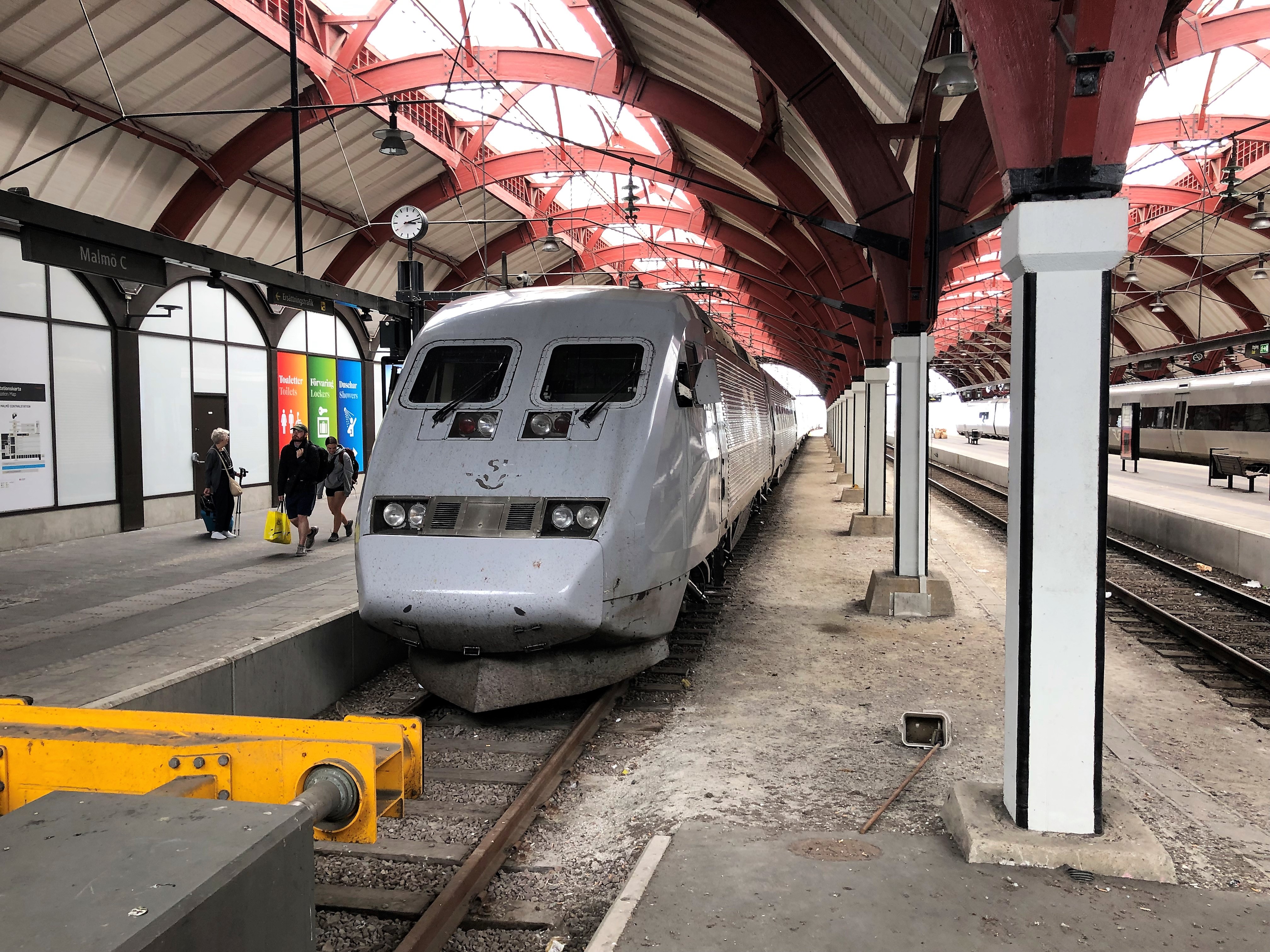
Let’s be clear: the X2 looks good but is not a V250 high-speed train according to UIC criteria. Its speed limit is 200km/h and in any case the relatively winding Swedish network rarely allows such speeds.

It’s a very comfortable train, with a very smooth ride. Fortunately, the X2 has the seating arrangement is like in an aeroplane, 2 by 2, which allows us to have our own little corner. But in a curious formation: one side of the corridor looks forward, the other looks back. One detail betrays the age of the trains: each seat still has a jack for headphones, from the time when music was played by train! It was the time without smartphones, in other words the prehistoric age for my son’s generation, who found the wifi « perfect » for football match summaries…
We back at Malmö in the underground side of the station, then we go to Öresund, Copenhagen airport and finally the « H » station, the central station of Copenhague, after 637 kilometres swallowed in 5h04. Yes, these X2s to Denmark are inevitably dual-current and have the signalling systems of both networks, Trafikverket and Banedanmark.

In Copenhague, the little station Østerport, in the north of the city, is worth a visit. It is a 15-minute walk from the famous Little Mermaid (Den Lille Havfrue in danish), and is suitable for a 20-25 minute walk along the water back to the city centre, towards the Nyhavn district, for those who know.
Østerport is for the rail fan a perfect example of what is possible to renew a station. These 6 tracks are overlooked by a splendid little passenger building that has managed to integrate… two cafés and a supermarket. This is great art and this shows how stations as large as Chesterfield (UK) or Lelystad (NL) can be revitalised.
Of course, the small Østerport station figures prominently on the Copenhagen S-Bane with almost a train every two minutes there! We are in the North but still in the city.
Copenhague-Brussels in one shot!
The best part was for the end: back to Brussels with 1,190 kilometres in one go, in three « synchronised » trains. We can say that we have seen it all…
At 9.19 am we found an IC3 diesel DSB taking us directly from Copenhagen to Hamburg. We both had aisle seats in a 4-seater vis-à-vis. Unfortunately, the mother got up every 30 minutes to go to the toilet or to get something from her bag. The little daughter was the wiser one. At the risk of sounding unsocial (but I assume so): the comfort of the train is also made by the passengers! The arrival in Hamburg is drinkable (we’ll learn later that there’s a signalling failure…). It’s Friday and the station is full of soldiers going home.
It’s with a certain fear that we see the Danish mother and her child taking the same train as us to Cologne. Luckily, they won’t be in our car. Our IC 2213 is a classic Deutsche Bahn Intercity train pushed/pulled by a locomotive 101, a Stralsund-Hamburg-Cologne-Stuttgart. Bpmmz car with 2 seats arrangement, someone was occupying our seat but it was released without any problem.

In the train to Cologne, we can see one of the bad sides of the Deutsche Bahn: the fact that it is not compulsory to reserve a seat on long-distance trains, because for certain types of ticket, reserving a seat means paying a supplement. In fact, people get on these long-distance IC trains hoping to find a free, unreserved seat at random. Moral of the matter is that on departure from Hamburg, 10 to 15 people are standing on each side of the car. Some people raise their voices, they get angry, the toilets are unreachable, and you can imagine that it’s the same for the whole train. Where is the customer experience here? Apparently there are Friday regulars who don’t mind. Good for them. The situation will improve from Bremen onwards with the release of several seats, but the train is still very full. Friday in Germany, but I presumes that is the same situation in other countries…
A bad intuition asks me to check if our third train Cologne-Brussels is running. With much difficulty I manage to get the online timetable of the said train and I can read already the superb message ‘hohe Auslastnung erwartet‘ (expected high occupancy rate). The arrival in Cologne confirms my fears mentioned at the beginning of the article, but worse. All trains are between 15 and… 90 minutes late! An ICE to Amsterdam on track 5 doesn’t seem to want to leave. It seems to be a complete mess, except for some regional trains.

It’s 7.10pm in Cologne, our 7.40pm ICE 10 is not yet announced, but the previous ICE 12 of 5.43pm does arrive at 7.30pm (2 hours late), in the A-D part of platform 4 rather than D-G. The crowd runs to the other end of the platform. It is at this precise moment that you have to make a decision in 2 seconds: take a train not listed on your ticket, move to the bar and stay there. In 3 minutes, the 12 m² of this relaxation area is filled with backpacks and their owners. Everything is blocked. The DB security staff is on the platforms and tries to filter. Too late everyone is on board, sitting or standing. Around 7.45pm we leave… with applause (I guess it was the people who were waiting for their ICE for 2 hours…).
Two hours on our feet, we won’t complain, at least we were back on time. A quick last look on the app to see the situation of our « real ICE », the one we were supposed to take: it was an hour late in Cologne. This is no longer our problem. At 9.55pm in Brussels we took our last train to back home.
End of the journey, end of the palpitations, a great experience. 10 trains aeged between 20 and 30 years old (admittedly relifted) and 3,645 kilometres, including 1,108 were covered with fossil fuels. Is this really the way to save the planet? Can we really attract air and road customers like this? It’s up to each of us. So much room for improvement.
And by the way what did we pay?
This is summarised in the table below. Interrail? We could have. But with 586 € for two pass, we still had to count the numerous supplements, which bring us over 650 € if not more. And we would not have been able to experience the first class between Brussels and Hamburg. All reservations roughly one month before departure.
Four websites were necessary but let’s be honest, the whole thing took a good 45 minutes, on a quiet evening at home (except for that moment of irritation with Deutsche Bahn, which led me to go to Omio…).

It is deliberately that the right column only takes the kilometre rate per person. Snälltåget is at the top of the ranking with 50% cheaper fares per kilometre in Sweden than the national public operator, which seems to have made some efforts itself when you compare the kilometre rate in Germany and Denmark: 0,08€/km in Sweden against 0,11 to 0,13€/km in Denmark and Germany. The Hamburg-Malmö route is the most expensive per kilometre, and using an alternative site did not mean lower fares. Special mention for SNCB for the 676 kilometres in first class, i.e. 0.12€/km compared to 0.13€/km in second class on a shorter Hamburg-Malmö journey. A promotion? We don’t know.
It remains to be seen whether it is more expensive than the same journey by car, because by the end we paid 0.20€ per kilometre for 2 people. It’s up to you to draw the appropriate conclusions, but be careful not to compare what is comparable.
It is likely that we could have done better in terms of price, and it also depends on your concept of travel. Everyone has his or her own definition of tourism, of adventure, and the adventures described in this article may seem of little importance to others. So much the better. But put yourself in the shoes of the people you need to convince.
Our experiment was to take different trains and see to what extent the many romantic readings associated with train travel (good for the planet) were able to attract tourists from planes and cars. I’m afraid there’s still a lot of work to be done…

(1) When Deutsche Bahn launched its ‘Jede Stunde, Jede Klasse‘ (every hour in every class) Intercity service in 1979, it offered a platform-to-platform connection between two ICs in certain key stations such as Mannheim in… 4 minutes! Another era…
07/08/2022 – By Frédéric de Kemmeter – Railway signalling
Suscribe my blog
Related topics:
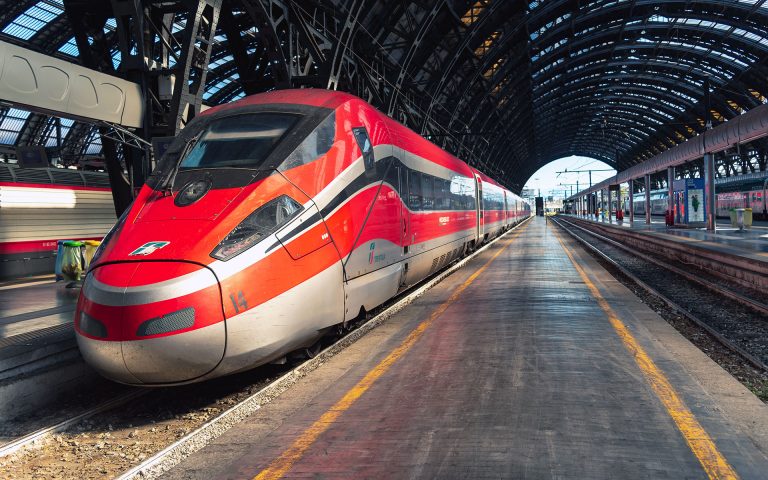 Want to save the environment? Then you should stop traveling !
Want to save the environment? Then you should stop traveling !
02/11/2020 – Why a climate lockdown and the local economy can put the train at risk? If there is no more travel, there are no more trains. If the economy is local, there are no more freight trains. xxxxxxxxxxxxxxxxxxxxxxxxxxxxx xxxxx xxxxxxxxxx xxxxxxxxxxx xxxxxxxxxx
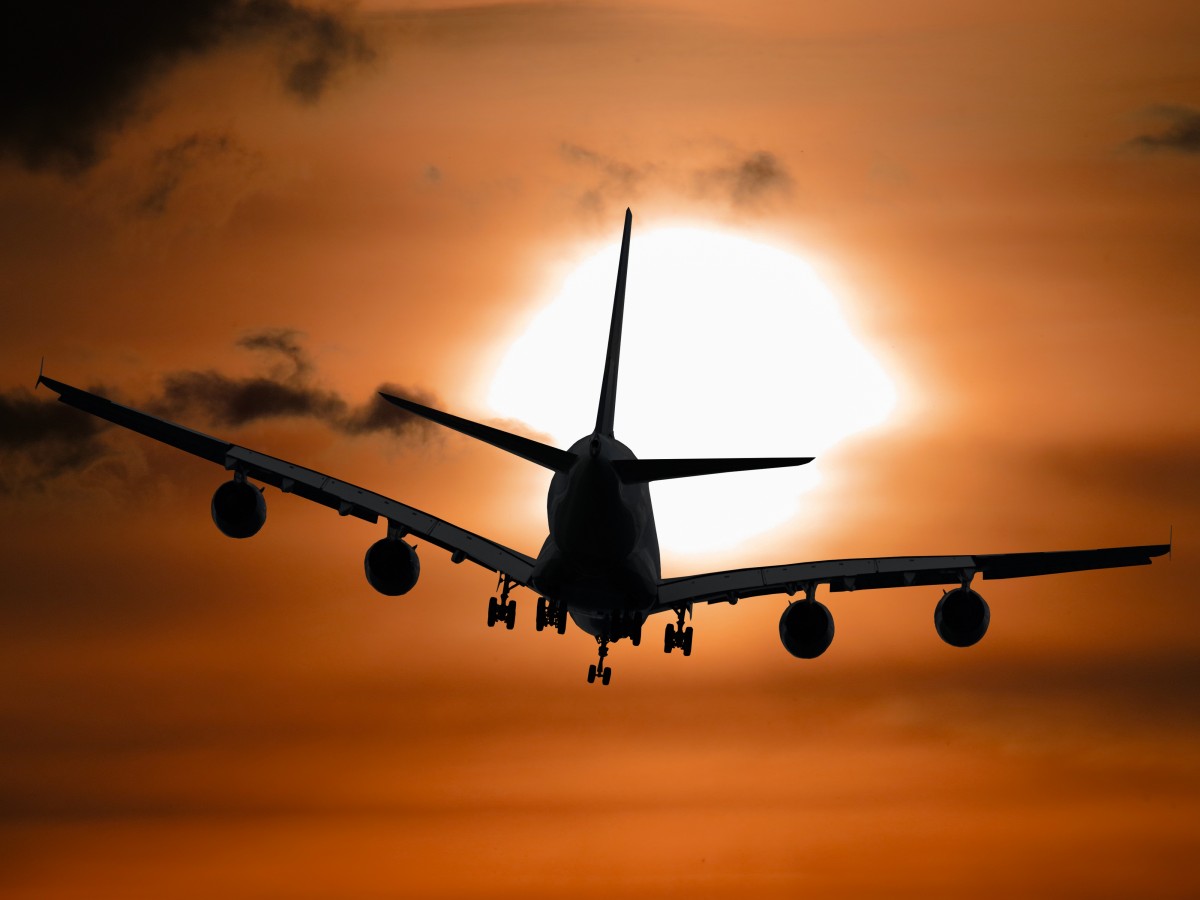 Can the train really replace the plane?
Can the train really replace the plane?
28/06/2021 – The train could replace some 500 to 1000km flights. Mentalities seem to be evolving in this direction and the average travel time would increase. But there are still a number of conditions for this replacement. xxxxxxxxxxxxxxxxxxxxxxxxxxxxx xxxxx xxxxxxxxxx xxxxxxxxxx xxxxxxx xxxxxxxxx xxxxxxxx xxxxxxxxxxx
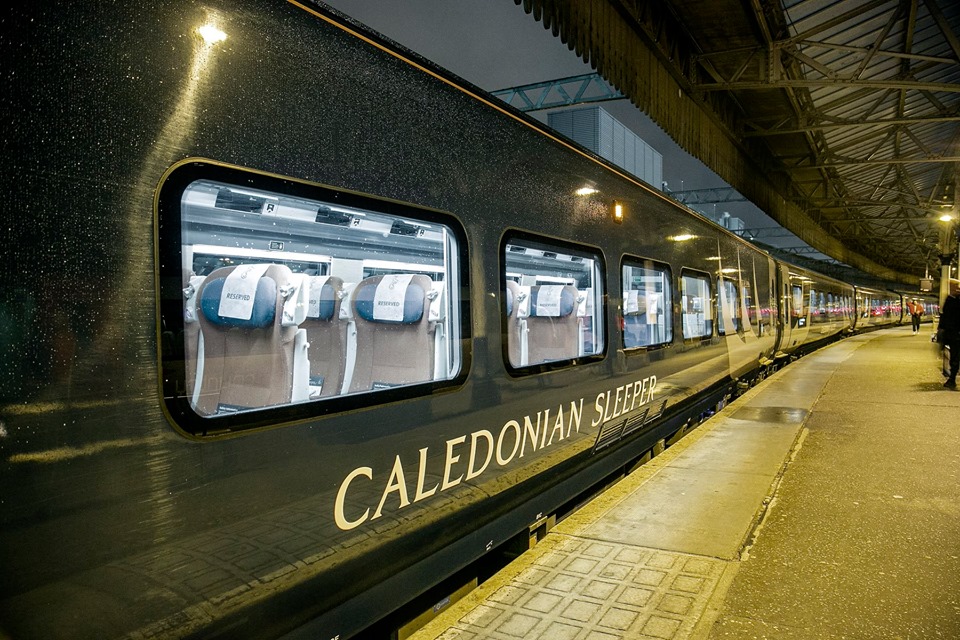 How the night train could be an asset for the railways
How the night train could be an asset for the railways
18/01/2021 – Night trains can be an asset for the railways, rather than a constraint. Provided that it is taken as a special segment with a strong business model.xxxxxxxxxxxxxxxxxxxxxxxxxxxxx xxxxx xxxxxxxxxx xxxxxxxxxx xxxxxxx xxxxxxxxx xxxxxxxx xxxxxxxxxxx
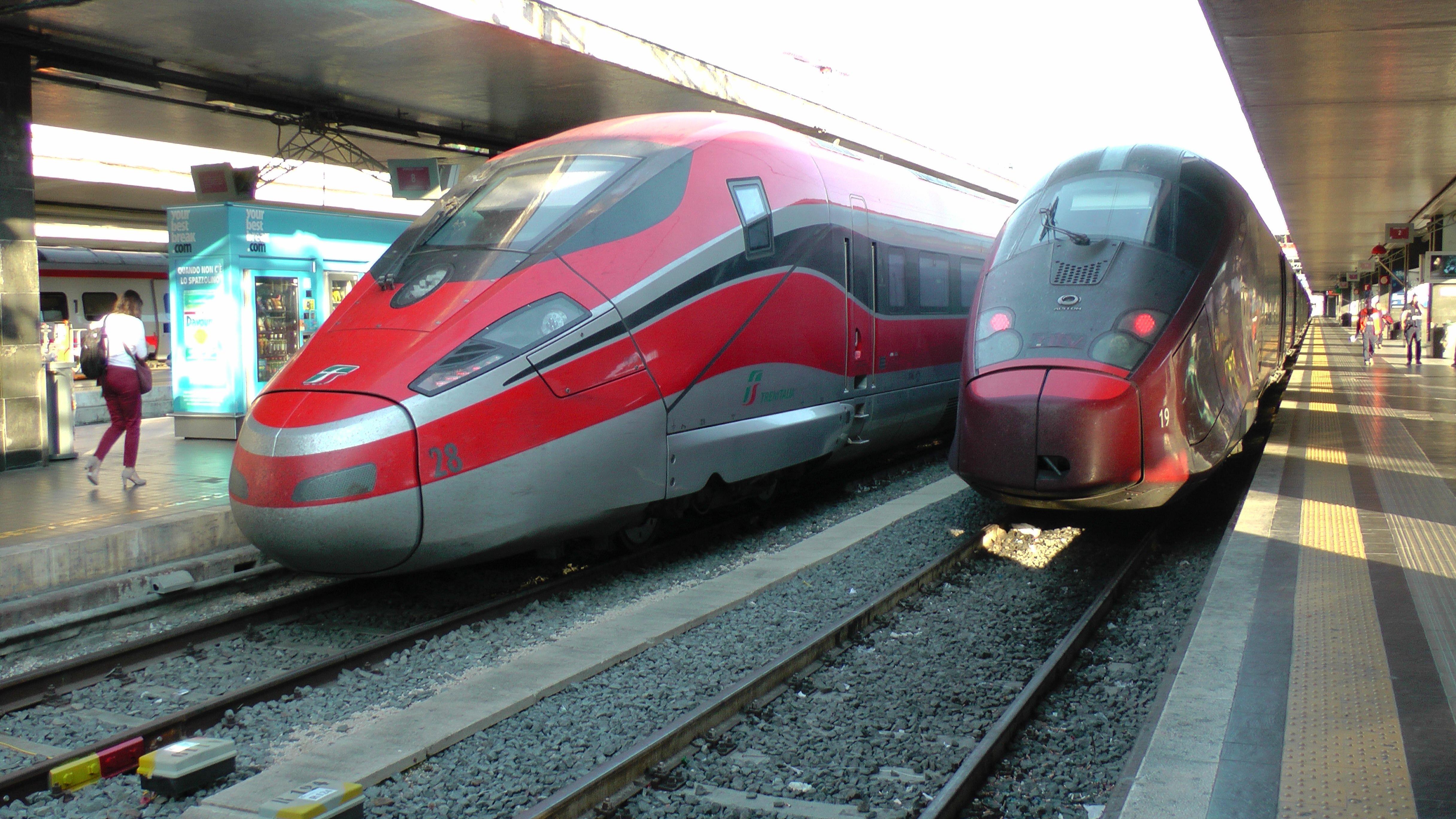 More operators are needed to contribute to more modal shift
More operators are needed to contribute to more modal shift
16/08/2020 – The railway is not able to cover a maximum of our mobility needs. Not really because there are other modes of transport, but because there are not enough operators and innovation.xxxxxxxxxxxxxxxxxxxxxxxxxxxxx xxxxx xxxxxxxxxx xxxxxxxxxx xxxxxxx xxxxxxxxx xxxxxxxx xxxxxxxxxxx
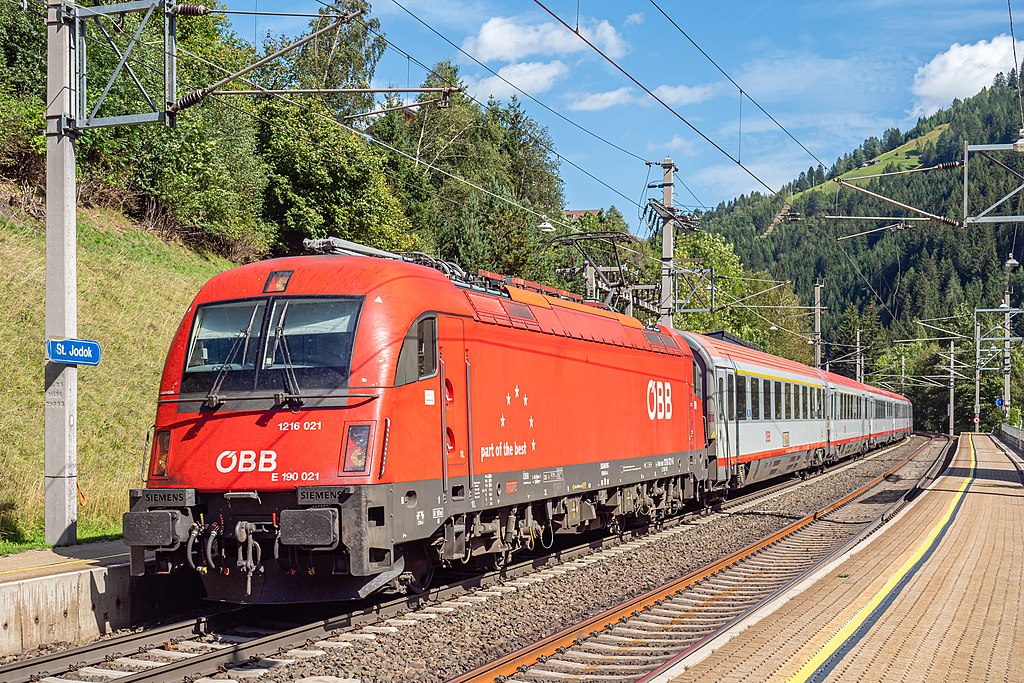 More needs to be done to promote rail transport
More needs to be done to promote rail transport
20/03/2022 – Rail is no longer the dominant transport mode it was in the 1950s. Today, it has to become the first choice again if it is to hold its own against its competitors. A very difficult task, but not impossible. However, there are two schools of thought on how to bring the train back into the limelight.


Vous devez être connecté pour poster un commentaire.